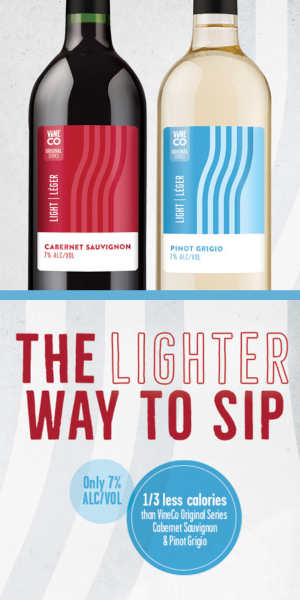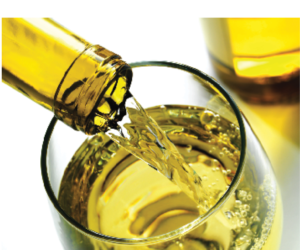As budding winemakers, one important principle we heed is protecting juice (must) and wine from oxygen’s baneful effects. But then we learn that yeast needs a “little” oxygen for a good fermentation, that reds benefit from “some” aeration, and that some white varietals can be subjected to lots of oxygen with no ill-effects while others need complete protection. In this issue, we take a behind-the-scene look at oxidation phenomena in musts and wines to get a better appreciation of oxygen properties and chemistry in winemaking. Understanding O2 properties and chemistry and mastering O2 management will go a long way in helping you create superior wines.
Note: in this article, “wine” will refer to either “must” or “wine” except where a distinction is necessary. Concentrations of compounds in wine will be denoted in square brackets; for example, [EtOH] denotes the concentration of ethanol (EtOH).
Properties of oxygen
There are two important oxygen properties to consider in winemaking: oxygen solubility and oxygen consumption.
Oxygen solubility refers to the maximum amount of molecular oxygen (O2) that can be dissolved in wine to reach saturation and is expressed in mg/L (often written as mg O2/L) though some literature uses mL/L. Using mg/L avoids confusion since the same weight of a gas can occupy different volumes. The actual amount of dissolved O2 (DO) in wine is denoted as [DO].
O2 solubility at 68 °F (20 °C) and unit atmospheric pressure in air-saturated wine is approximately 8.6 mg/L, and increases about 10% at temperatures 9 °F (5 °C) lower. It is about five times as great, or 43 mg/L, if pure O2 is used instead of air, which contains roughly 20% O2, to saturate the wine, for example, in such applications as micro-oxygenation where pure O2 is directly injected into wine.
O2 solubility is a function of temperature (T), surface area (A) exposed to air, partial pressure of oxygen over the wine, and is affected by the presence of ethanol (EtOH) and carbon dioxide (CO2). Partial pressure simply refers to atmospheric pressure exerted on wine under normal winemaking conditions, and so we’ll assume that it is always one atmosphere and ignore it in our analysis to keep things simple.
We can now formulate the relationship between O2 and those factors:
O2 solubility increases as T decreases, [A] increases, [EtOH] increases, or [CO2] decreases.
What this means is that, as must becomes wine and is processed at colder temperatures from the fall season or, for example, from cold stabilization, more O2 dissolves into wine, i.e. [DO] increases. Sulfur dioxide (SO2) cannot slow down solubility as it does not react with molecular O2.
As long as wine has additional capacity, it will continue absorbing O2 while exposed to air. And so, wine has the potential to oxidize more readily than must, particularly that wine is subjected to more high-O2-intake processing such as racking and pumping, which inevitably increase the liquid–air surface area. Generally, DO should not exceed 2 mg/L at bottling. Racking with aeration can add as much as 8 mg O2/L, and so, it is not recommended just before bottling. Commercial bottling lines use special equipment and inert gases to limit O2 uptake to as little as 0.3 mg/L—it can be in the order of ten times more with home winemaking equipment. And remember: wine continues to absorb O2, albeit very slowly, during bottle aging due to headspace O2 as well as O2 ingress permeating closures.
Oxygen consumption refers to how DO reacts with other wine compounds (and micro-organisms) during processing and aging, and how [DO] changes. O2 consumption is different in must vs. wine and is affected by temperature (T), polyphenol (PP) concentration, and catalytic iron/copper ion (Fe2+/Fe3+ and Cu+/Cu2+) concentrations.
We can formulate another relationship: O2 consumption increases as T increases, [PP] increases, [Fe2+/Fe3+] or [Cu+/Cu2+] increase, or as pH increases.
Again, SO2 does not consume O2 directly, but ascorbic acid is able to react and consume O2, and in the process produce hydrogen peroxide (H2O2) — that’s right, the same compound found in pharmacy-grade hydrogen peroxide — a known powerful oxidizer. H2O2 is also an oxygen radical — that means that O2 can be reduced (the opposite of oxidized) to H2O2, particularly in the presence of metal ions — and cause oxidative changes in wine.
Let’s put all this into perspective: at low temperatures, O2 is more soluble in musts and wines though less reactive; however, higher levels of DO can suddenly become very reactive if temperature increases. DO is not as much of a concern in musts at low temperatures, which are preferable to control spoilage micro-organisms, in spite of greater O2 solubility; what is important is O2 interactions with other wine compounds and its consumption. But in wines, O2 interactions slow down and O2 solubility increases slightly in the presence of EtOH, and so, DO can linger around for longer to interact with other compounds and cause oxidative effects, particularly with increasing temperatures even when the wine is protected from oxygen.
Oxidation in must
Polyphenols are the main substrates of both enzymatic and chemical (non-enzymatic) oxidation in must.
Enzymatic oxidation is activated by naturally occurring polyphenoloxidase enzymes (PPOs) in the presence of oxygen as soon as grapes are crushed or pressed and cause polyphenols in grape pulp and those extracted from grape skins during maceration to oxidize to brown-colored quinones in what is known as phenolic browning. PPOs become inactive by the end of fermentation. Quinones can be reduced back to their polyphenols and reverse browning effects through SO2 or ascorbic acid additions.
Phenolic browning is particularly problematic at higher pH because of the higher concentration of oxidizable polyphenol ions, and at higher temperatures, which tend to accelerate oxidative effects. This can begin in ruptured grape berries hanging on the vines or in grapes damaged from handling or during transportation to the winery. And moldy B. cinerea-affected grapes contain naturally occurring laccase enzymes that further exacerbate oxidation and which can have longer-lasting activity well into the wine aging phase, and are relatively immune to sulfite. Moldy berries and bunches should be removed to the extent possible.
Must also contains glutathione (GSH) — a tripeptide, i.e. three amino acids linked together — that acts as a natural antioxidant by reacting with quinones to form colorless glutathione-containing complexes known as grape reaction products (GRP). However, when GSH becomes depleted, any remaining quinones undergo a coupled oxidation that exacerbates browning by forming secondary quinones that can go on to react with other polyphenols to form aggregate complexes and impact color intensity and stability. Some polyphenols are also regenerated during this coupled oxidation therefore renewing the potential for phenolic browning if PPOs and O2 are
still available.
Oxidation in wine
Polyphenols are the main substrates of chemical oxidation in wine, but here, oxidation is catalyzed by iron and copper metal ions, which occur naturally in tiny quantities in grapes but can become significant if, for example, brass or copper equipment is used or if vines and wine are treated excessively with copper. Copper sulfate (CuSO4) sprays are used in the vineyard to control mildew while dilute CuSO4 is used to treat reductive aromas such as those from hydrogen sulfide (H2S).
But bisulfite ions from SO2 additions can also bind directly with quinones (instead of reducing these to colorless polyphenols) to form bisulfite addition products that can no longer be reversed back to colorless forms.
In the presence of metal ions, O2 can become reduced into H2O2, which can oxidize bisulfite ions into sulfates and divert free SO2 from performing its protective duties. H2O2 can also oxidize ethanol into acetaldehyde. If caught quickly, SO2 can be added to get bisulfite ions to bind and deal with the acetaldehyde; otherwise, acetaldehyde will bind with tannins and anthocyanins and even cause tannins to bind with anthocyanins to form complex pigmented polymers that will alter wine color and stability.
If quinones are left untreated or cannot be reduced back to their polyphenols, they too can bind with tannins and anthocyanins to form very complex pigmented polymers that will aggravate color problems.
Adding ascorbic acid can become risky if there are no more brown-colored quinones to react with; then, ascorbic acid can start converting O2 into H2O2 and exacerbate oxidation problems. So you must be in tune with the chemistry of your wine before using ascorbic acid. And remember: ascorbic acid must be used with SO2 to allow bisulfite ions to deal with H2O2 and reduce oxidative effects.
These effects will manifest themselves differently throughout wine pH range, a phenomenon mainly important in red wine. These mechanisms are very intricate, but suffice to say here that a greater concentration of oxidizable phenolic ions exist due to the greater dissociation at higher pH. This means that color will be less intense and less stable at higher pH.
Microbiological oxidation
Enzymatic microbiological oxidation refers to aerobic activities in S. cerevisiae yeast necessary to support cell growth and survival for alcoholic fermentation (AF) to proceed, and in potentially harmful rogue yeasts and bacteria.
During AF, yeast cells need 5–10 mg O2/L to produce unsaturated fatty acids, phospholipids and sterols required for building cell membranes. Since this much O2 exceeds available O2 (i.e. [DO]), oxygen needs to be replenished.
Yeast lees can continue consuming O2 well past the end of AF for months, and longer during sur-lie aging, which can cause wine to become reductive and take on a sulfurous smell. Avoid this by supplying extra oxygen to yeast during fermentation if you are planning aging on the lees. Wine also ages at a slower rate during the maturation phase since lees consume O2 at a faster rate than polyphenols do, i.e. more polyphenols hang around for longer to deal with O2 being absorbed into wine.
During malolactic fermentation, air ingress should be minimized as lactic acid bacteria can use O2 to convert citric acid into possibly high amounts of diacetyl and acetoin that can make wine overly “buttery,” or to metabolize tartaric acid into objectionable levels of lactic, succinic and acetic acids, which can make wine limp and flat and take on a vinegary smell.
Indigenous surface yeast on grapes can use O2 to form a whitish-grey film on the surface of wine along with nasty off-aromas and flavors if wine is excessively exposed to air. Detectable levels of acetaldehyde may be an indication that surface yeasts have begun their destructive effects. Given their high resistance to SO2, sulfite is ineffective in preventing or curing surface yeast problems. Good viticultural practices, sound winemaking practices, sanitation in the winery and avoiding excessive exposure to air are the best prevention here.
Brettanomyces yeast can use O2 to convert phenolic acids into ethyl phenols and impart a smell of barnyard. Control Brett by maintaining anaerobic conditions as small amounts of DO react more favorably via chemical oxidation with other compounds, giving little chance to this yeast to manifest itself.







